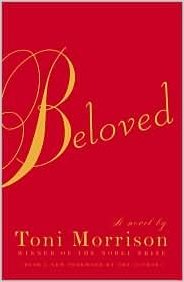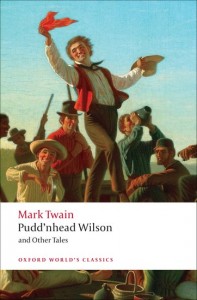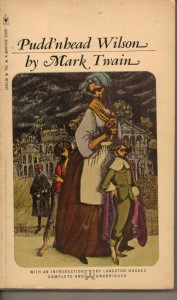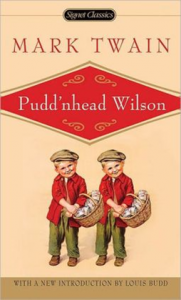Jazmine Dubois
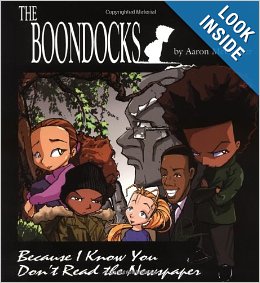
Character: Jazmine Dubois
Source Text: McGruder, Aaron. Boondocks: Because I Know You Don’t Read Yhe Newspaper
Entry Author: David Lwamugira
Aaron McGruder’s highly intelligent and racially charged comic strip, the Boondocks, provides readers some insight into the thinking of a pair of African American youths named, Huey and Riley, who must navigate their way through a mostly white society. The neighbor of these characters , Jazmine, acts a literal bridge between the two worlds because she has a black father and a white mother. During Jazmine’s first interaction with Huey, Huey tells her, much to her despair, that “it’s good to have more black people around.” Jazmine disputes the fact she is black and asks Huey why he would assume what race she was. Huey responds by saying, “Well first of all, Mariah, your afro is bigger than mine.” When she responds with, “I don’t have an afro – my hair is just a little frizzy today,” Huey retorts: “Angela Davis’ hair was ‘a little frizzy.’ you have an afro.” Jazmine then screams in protest, “I DO NOT and who is Angela Davis?” Huey compares Jazmine to Angela Davis, an African American political activist who took part in the Civil Rights movement and she fails to catch the reference. This shows that Jazmine has the physical appearance of an African American but does not fully identify herself as a member of the community, as well as the gap in historical knowledge between Huey, an African American, and Jazmine, a member of both the White and African American communities.
Jazmine’s identity is constantly being determined by others. When asked by a school questionnaire what race or ethnicity Jazmine belongs to, Jazmine leaves the field blank. The elementary school principal calls Jazmine’s mother in order to get a straight answer and she says it’s up to Jazmine to construct her own identity: “We don’t want anyone doing that for her. Is that clear? If she must be called anything, use the term ‘multiracial.’ Never ‘white,’ never ‘black.’ Ok?” Immediately after this speech, the principal decides to ignore her mother’s advice and identify Jazmine as an African American. So many people in this world ignore the fact Jazmine is a mixture of races. By defining her as one or the other, they limit her growth as a person.
In a moment of desperation, Jazmine expresses her feelings in a very open and honest manner that captures the experience of being biracial:Most people don’t understand what its like being different. Like…I once saw a yellow flower right in the middle of a bunch of red roses…everything around it was either green or red, and here was this yellow flower. It looked lonely. That’s what it’s like being biracial. I’m different from everyone else. My mom and dad say that makes me special, but i just think it’s lonely. (McGruder 27)
Her soliloquy shows the reader she is just a young girl trying to find acceptance in a world where defining someone’s race can still mean defining their character. Jazmine wants to live her life free of judgment or the pressure to choose which race she shall identify with. Yet the notion of belonging to one race or another matters much more to her peers than it does to her. Like any human being, Jazmine wants to be treated with decency and respect.
Beloved
Character: Beloved
Source Text: Morrison, Toni. Beloved. New York: Random House, 2004. Print. First Vintage International Edition.
Entry Author: Lauren Cyr
Beloved is the daughter of Sethe, a runaway slave woman who suffered terrible abuse at a plantation named Sweet Home. After escaping from Sweet Home, Sethe traveled to her mother-in-law’s house in Cincinnati, eventually settling down to raise her children. However, she is found out by her master, who comes to her house in order to reclaim her and her children. Unwilling to return into a life of slavery, Sethe grabs her children and tries to kill them. The eldest child Beloved, is killed by Sethe, who cut open the child’s neck with a saw. Sethe claims to have been “trying to put my babies where they would be safe.”
After this event, Sethe returns to live in the house where the murder occurred. Although, the house has gained a new addition; the house remains haunted by the spirit of Beloved. The spirit moves objects around the room, flips tables and rattles chairs. Sethe’s two male children, as well as the house dog, are chased out of the house by the spirit. Her presence is destructive, yet tolerated by the members of the house. Beloved’s spirit reminds Sethe’s family of the horrors of slavery, and the need to address their traumatic past.
Once a friend of Sethe’s from Sweet Home shows up in Cincinnati and comes to stay with the house, Beloved’s spirit is apparently chased out of the house. The house goes quiet, and the ghost is believed to have moved on. However, at this point, a young black female is found sitting in front of the house, who calls herself “Beloved.”
Beloved is an animated corpse, or a physical embodiment of the ghost that has been terrorizing the household. Beloved’s physical hybridity takes on a cultural symbolism as well: she gives voice to the horrors of slavery, embodying the unknown collective unconscious voices of former slaves, and relaying their history from the time of the Atlantic passage onwards. She is representative of a past community, and expresses all the tendencies of rage and revenge for those who have died. Sethe is paralyzed by Beloved as the corpse feeds off of her body, emotionally draining Sethe.
The only way Beloved can be gotten rid of is through an act of exorcism by the community. The greatest role the African-American diaspora community has is to seek to heal its members from the traumatic experiences of their past. Therefore, in a climactic experience in the novel, the women of the community gather to perform an exorcism, to force out the demons of the past that have been haunting Sethe. When Ella, a member of the community finds out that the corpse of Beloved has been draining Sethe, she feels incredible outrage. As Ella says, “She didn’t mind a little communication between the two worlds, but this was an invasion” (Morrison 303). The outrage from the community comes from the fact that the past has become a body, physically tormenting Sethe’s life. Therefore it becomes the physical job of the community as a restorative force to begin an exorcism on behalf of Sethe.
About thirty women gather together outside of Sethe’s house and begin to pray and sing. The voices begin to blend together, drawing out Sethe and Beloved. This force of healing is so great that it forces Beloved out of Sethe’s life, exorcising the negative consuming influence of the past. The spirit of Beloved is seen as a necessary reminder of a traumatic past that must be dealt with by the individual; yet, when Beloved’s body changes into a physical being, her presence is too overwhelming and destructive, and must be communally dealt with.
Roxy
Character: Roxanna
Source Text: Twain, Mark, and R. D. Gooder. Pudd’nhead Wilson and Other Tales. Oxford [England: Oxford UP, 1992. Print.
Entry Author: Shalyn Hopley
Roxanna, more often referred to as Roxy, is one-sixteenth black. Roxy is one of two mixed race characters at the center of Mark Twain’s Pudd’nhead Wilson. Roxy is a slave, but “to all intents and purposes Roxy was as white as anybody, but her one sixteenth of her which was black outvoted the other fifteen parts and made her a negro,” (Twain 8). She is described as looking as white, but her mannerisms are fitting of a black slave. Roxy is the caretaker for two boys, her own son and the white son of her masters. Both children are indistinguishable without clothing by the master of the house. Roxy’s actions regarding the children are central to the plot of Twain’s novella. In a fit of panic about the possibility of her own child being sold “down the river”, Roxy decides to kill herself and her child. Before carrying out the act, she dressed both herself and her son in their finest clothing. Upon seeing her child, she realizes she can switch the children, which she does, and pass her son off as the master. The children, Tom, the master’s son, and Chambers, her own child, are given each other identities in infancy and it is this action that carries the novel forward.
Roxy is a complicated character, drawn complexly at the center of the complications of an illogical system of blood. Roxy eventually is freed by her master Driscoll and works her own way on a river boat. She watches Tom, who was originally Chambers, grow into a spoiled child who scorns her. She reveals to Tom his heritage, and they together concoct schemes, yet she is still betrayed by Tom who sells her back into slavery down the river. While Roxy’s actions are revolutionary and challenge the status quo on face value, they ultimately are problematic. Firstly her actions are not openly defiant, nor are they the most ethical. Her switch is like an “eye for an eye,” a child for a child. She condemns Chambers to a life of slavery and the possibility of being sold down the river. While she subverts the system by having a “black” child in the position of master and a white child in the position of slave, she has not found a means to truly affect change. She has made one individual change while the system remains intact. Additionally, her actions are ultimately righted with disastrous consequences for all involved. Tom is condemned to slavery, sold to the men to whom he owed gambling debts; Chambers rises into a class he is unable to fit into due to his upbringing; Roxy’s heart was broken by the misfortunes that have befallen her son and the child she condemned to slavery. Roxy may try to challenge the status quo in Dawson’s Landing but she is not successful, her actions producing no victories, the system of blood continued.
Thomas Chambers
Character: Thomas Driscoll
Source Text: Twain, Mark and Sidney E. Berger. Pudd’nhead Wilson and Those Extraordinary Twins: Authoritative Texts, Textual Introduction and Tables of Variants, Criticism. New York: Norton, 2005.
Entry Author: Jonah Beukman
Mark Twain’s Pudd’nhead Wilson satirizes a culture in which titles and nobility hold significant value. The dominant culture in the novel, which is one of affluence and “whiteness”, is proven to be superficial and false. Twain indicts a society that equates whiteness with nobility and blackness with bad character and complicates this notion with Thomas Driscoll, who is mixed race; his identity is not fixed and his malevolence as a character cannot be linked to biological determinism. Both Tom and his brother Chambers are one-thirtysecond white, yet Chambers is made out to be a benevolent character, whereas Tom is seen as wicked. His role in the social and societal settings of the novel is that of an antagonist, seen mostly in the act of selling his mother, Roxana, down the river as a slave. Yet he is not entirely unsympathetic, and Mark Twain complicates the notion of Tom’s “wicked” identity being due to his race. Tom’s identity as a mixed-race character is put into question in the following passage:
It was the “nigger” in him asserting its humility, and [Tom] blushed and was abashed. And the “nigger” in him was surprised when the white friend put out his hand for a shake
with him. He found the “nigger” in him involuntarily giving the road, on the sidewalk, to the white rowdy and loafer. When Rowena, the dearest thing his heart knew, invited him
in, the “nigger” in him made an embarrassed excuse and was afraid to enter and sit with the dread white folks on equal terms. The “nigger” in him went shrinking and skulking here and there and yonder, and fancying it saw suspicion in all faces, tones, and gestures (49).
Mark Twain puts into question several dichotomies here which relate to mixed-race and mixed identity. He satirizes the notion that being black is synonymous with being meek and unassertive, while complicating Tom’s actions as a character. “The ‘nigger’ in Tom” refuses to acknowledge white individuals. He “involuntarily gives the road” to white individuals who are not necessarily worthy of his respect as an act of deference. The word involuntarily suggests that at least part of Tom’s identity is inherent regardless of race, despite Twain’s false and superficial claim that “blackness” is on par with being evil. Tom also refuses to accept Rowena, “the dearest thing [that] his heart knew” inside, indicating that his black identity satirically informs sexual meekness as well. Tom goes “shrinking and skulking here and there and yonder” as a further indicator of Twain’s indictment of the waywardness of Black individuals. Black individuals may be wayward, according to Twain, but Tom’s mixed race and his acknowledgment of the dual identities that comes from both his “white” and “black” identities make him a character that defies the status quo. Twain himself defies the status quo as an author here through Tom’s duality in identity, which represents a prototype in post-structuralist thought
Roxana
Character: Roxana
Source Text: Mark Twain, Pudd’nhead Wilson and those Extraordinary Twins (1894)
Entry Author:
Roxana is a slave woman. Over many years of racial mixing in her ancestry, she no
longer appears black, the 1/16 portion remaining no longer expressing itself. To
outside observers she is white, “of majestic form and stature, her attitudes were
imposing and statuesque, and her gestures and movements distinguished by a noble
and stately grace.”(9) It is interesting to note that her white skin allows her the
agency to switch her children, an act that would denied to a black skinned black
person. Black skinned characters do not appear to have the ability to exercise
agency in any meaningful way of their own. It is only when she is heard speaking
that those who do not know her understand that she is a slave and is black. She
considers herself to be black as well, and does not find that particularly odd. She is a
nurse maid to the children of Mr. Driscoll, as well as having a child herself. She
switches her child with the child of the Driscoll’s so that he may grow up to be a free
man. Other slaves around her recognize her to be a black person. They react to her
easily as a member of their community. (9) Although Roxy is unable to pass for white
because of her speech habits, which mark her as a member of the slave caste, she
recognizes that because her master is unable to distinguish between the two
children, that she would be able to free her son from a lifetime of bondage by
exchanging him with the son of her master. This demonstrates that Roxana
understands that race is only skin deep. She doesn’t see a reason that her son
couldn’t take the place of a white boy if he looks the same. The conventions of black
inferiority do not seem to have worked themselves into her head completely. If she is
able to switch the roles of her children by switching their places, they should be able
to function in their new positions well. Unfortunately this belief that the character of
whites and blacks is fundamentally the same is untrue for her, and her child behaves
very poorly. But this is not because he is black, but because he is a product of his
environment. Like Roxy, who is white in appearance but raised and acts black, her
child raised as a spoiled white boy acts like one. Roxy is unable to take great
measures to enact her own freedom, like running for her life, she does find a way to
reclaim some power through the exchange of her child. Ultimately, Roxana
demonstrates that the character of a person is determined by their upbringing and
social status, not by the genes which they carry. Although the nature and nurture
debate is cast into a strange new realm today, where genetics are beginning to be
found to be responsible for some elements of a persons behavior, at least
pathologically, Roxana is a representative of a train of though which states that all
human behavior is rooted in nurture.
Quadroon Nurse
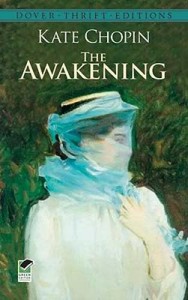
Character: Quadroon Nurse
Source Text: Kate Chopin, The Awakening (1899)
Entry Author: Maraed Dickinson
Racial Mix: Categorized by narrator as “Quadroon,” a term used to designate a person of white and one-quarter African ancestry.
The plot of The Awakening unfolds among a close-knit community of affluent conservative Creoles living in New Orleans during the late 1800s. The novel, coinciding with the early women’s movement, focuses on the increasingly rebellious behavior of Edna Pontellier, who rejects society’s expectations and searches for an identity independent from her role as wife and mother.
As Edna becomes increasingly absent from her prescribed familial role, entering into an affair and eventually moving out of her family home, the Quadroon Nurse performs the role of caretaker and constant companion to Edna’s two young boys. The nurse remains at Edna’s disposal: either to free her of responsibility, allowing her to explore her identity crisis or, be easily dismissed, so Edna can entertain a fantasy of motherly affection for brief periods. Edna can ignore them or, in spurts of focused attention, let off steam from her conflict with Robert by blaming the supposedly negligent quadroon.
The nurse’s effect on the status quo offers some debate. On the one hand, she maintains the status quo and structure of the society by keeping its individual unit, the household, functional despite brewing discontent. Her oppression and resignation to her domestic duties preserves the family. At the same time, the nurse’s compliance frees Edna to explore outside her marriage and her prescribed role in the Creole society. Eventually, Edna’s exploration culminates in her complete breakage from society through her suicide.
The nurse’s ultimate role is to enable the freedom of others, even the two young boys she watches, who exercise their white male privilege despite their young age. Even the youngsters “[look] upon [the quadroon nurse] as a huge encumbrance, only good to button up waists and panties and to brush and part hair; since it seemed to be a law of society that hair must be parted and brushed,” (19). The young boys move about freely with “the quadroon following at the respectful distance which they [require] her to observe,” (30).
At times, the Quadroon Nurse reflects Edna’s discontent from the burden to perform her societal role, but mostly, she absorbs those tensions. The nurse is given little dimensions otherwise. When she leaves, she “vanishe[s],” allowing us no look into her outside life. However, the readers are allowed small glimpses into an internal mental world separated from her domestic duties. The novel introduces her with her customary activity off following the children around but “with a faraway, meditative air,” indicating that her she is not mentally invested in her duties (3). Despite her subservience, the nurse maintains her hidden world of inner thoughts…. At times she “follow[s] them with little quick steps, having assumed a fictitious animation and alacrity for the occasion,” (139).
Unlike affluent white women, her class and race determines that she will always be expected to be capable, and never told she is weak and cannot lift a finger. Her acceptance of her role seems racialized. Complying with Edna’s whim of portrait painting, “the quadroon sat for hours before Edna’s palette, patient as a savage,” (148). Her presence becomes a faint “pursuing voice … lifted in mild protest and entreaty,” mixed with the sounds of the children’s “escaping feet” – a marker of her Sisyphean duties (129).
Roxanne
Character: Roxanna
Source Text: Twain, Mark, and Sidney E. Berger. Pudd’nhead Wilson and Those Extraordinary Twins: An Authoritative Text, Textual Notes, Criticism. New York: Norton, 1980. Print.
Entry Author: Claire Tierney
Roxy is 1/16th black and 15/16ths white in Mark Twain’s Pudd’nhead Wilson, where she is a slave to Percy Driscoll. She is resilient, resourceful, and pragmatic. She is very much a victim of her society and her station in life. She is described as looking white, “to all intents and purposes Roxy was as white as anybody; but the one.sixteenth of her which was black out-voted the other fifteen parts and made her a negro” (9).
She is described as beautiful, “Her complexion was very fair” and her hair was brown, “but it was not apparent because her head was bound about with a checkered handkerchief and the hair was concealed under it” (9). When she is “among her own caste” she had “an easy, independent carriage […] and a high and ‘sassy’ way” (9). But when she was around white people she was “meek and humble” (9). Society defines her as black only because of her tattered clothing and lower-class vernacular. These social constructions, along with her intellect and strength, highlight the fallaciousness of Dawson’s Landing’s definitions of race.
Her sense of morality is constantly in question. Early on the novel when she sees Judge Driscoll has left some money out, she does not take it, thanking the fact that she “was saved in the nick of time by a revival”, saying “‘Dad blame dat revival, I wist it had a ben put off till tomorrow” (12). Later on in the novel her only concern becomes protecting herself and her son. She is willing to do anything for him. She complicates the binary of good and evil, and becomes increasingly darker throughout the novel. This is a direct result of desperation, as she is forced to make decisions more erratically.
She switches Tom and Chambers in their infancy in an effort to save her son the pain of serving the same life sentence of slavery that she has endured. Nevertheless, she enjoys seeing her son, a black man, in a position of power. She actively seeks to change the status quo in her society, and uses her and her son’s multiraciality to do so.
Later when the death of Judge Driscoll frees Roxy, she works hard until her body is arthritic, and she comes back to see her son. She becomes enraged when she sees that her son has become a criminal, squandering the opportunity she gave him by falling prey to society’s spoiling of him. She takes control of his life, demanding that he turn over a part of his allowance to her. She masterminds criminal plans with her son, and he betrays her, selling her “down the river” to an abusive slave master. She escapes by attacking her overseer and returns to Tom, telling him that she will reveal his true identity as a black man if he does not buy her freedom. After Tom fails at doing this, and gets caught in the Murder of Judge Driscoll, Roxy lives the duration of her life with “the spirit in her eye quenched” and “the voice of her laughter ceased in the land” (120). She fulfills the prophecy of the tragic mulatto, forever an outcast to society, forever miserable.
Roxy comports herself with confidence as a beautiful light-skinned woman around black people, and as a lowly ignorant black woman among white people. Her presentation, her vernacular, and even her morality are largely defined by the perceptions of those around her, more than how she defines herself. Despite her pragmatism and attempts at disrupting the status quo, she falls victim to society’s cruel logic.
Tom Driscoll (Valet de Chambre)
Character: Tom Driscoll (Valet de Chambre)
Source Text: Mark Twain, The Tragedy of Pudd’nhead Wilson (1894)
Entry Author: Adam Kelley
The character known throughout the text of Puddn’head Wilson as Tom Driscoll, a white southern aristocrat, was actually born Valet de Chambre, a mixed race child born a slave, but was switched at birth by his slave mother Roxana, “Roxy”. Chambers, hereafter referred to as Tom, ‘passes’ as the son of Judge Driscoll, descended from the “First Families” of aristocratic “Old Virginia” lineage. Tom’s real identity is later revealed using forensic evidence that proves his birth, but his appearance and success as an imposter challenge 19th century notions of racial identity. Tom, is born a ‘black’ slave by the ‘one drop’ rule, lives half his life as free white man of a locally respected family, and is ultimately revealed and sold back into slavery. The irony of his fate draws out the arbitrary nature of socially and legally constructed racial identity.
The imposter Tom’s race is known through his mixed race mother Roxy. The narrator describes her as “white as anybody, but the one sixteenth of her which was black out voted the other fifteen parts and made her a negro” (Twain 9). Twain’s matter-of-fact tone parodies the absurd nature of 19th century legal definitions of race. He presses this point farther when he describes of Roxy’s son that “he was thirty-one parts white, and he, too, was a slave, and by a fiction of law and custom a negro” (9). Both Roxy’s and her child’s racial status is defined legally in terms of the “one drop rule” that defines them as slaves by descent.
Physically, Roxy’s son ‘Chambers’ and the child Tom Driscoll appear identical. Twain describes of Chambers that “he had blue eyes and flaxen curls, like his white comrade” (9). The only discernable marker between the two infants is their clothing: the Driscoll child dressed in the finest garb and ornament, and Chambers stuffed into a “course” shirt that “barely reached his knees” (9). This further links the racial identity of the children to social cues imbedded in status symbols, and not in anything inherent in the children themselves.
Later in life the imposter Tom is informed by his mother that he was switched at birth and this has a devastating effect on his sense of self. After the revelation he wakes in the morning to exclaim the infamous lines “‘A nigger!—I am a nigger!—oh, I wish I was dead!’” (48). Profoundly disturbed by the news of his origin, Tom’s personality is shattered and he immediately begins to internalize the racial stereotypes he once cast on others. He feels “the curse of Ham upon him” (49) and “the ‘nigger’ in him was ashamed to sit at the white folks table” (49). He becomes deeply aware of his vulnerability under the law, and lives his life in constant fear of being found out.
All of Tom’s social relationships become inverted: his mother, once his slave, now lords her secret knowledge of his identity over him, and his perception of his relationship to his Uncle and his community alters drastically from entitlement to suspicion. His drastic shift in mood draws out the effects of racial prejudice on the marginalized of society. Tom is unwittingly forced into the position of ‘passing’ as white, and grows up oblivious of his origin. But, once he learns his true origin, he immediately begins to question his own identity and alters his personality and behavior. Nevertheless, Tom is consistently a despicable character: callous, cruel, and manipulative, but his punishment of being “sold down the river” feels unjust even for such an unlikable person. Tom, although being guilty of multiple counts of theft and even a murder, is ultimately punished merely for being a fraction ‘negro’.

